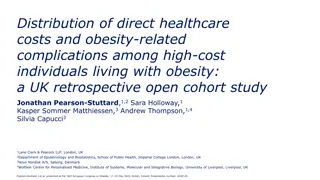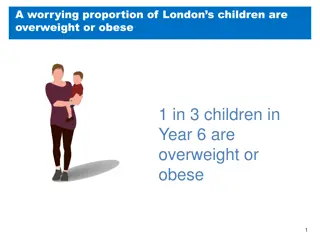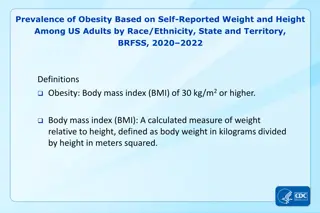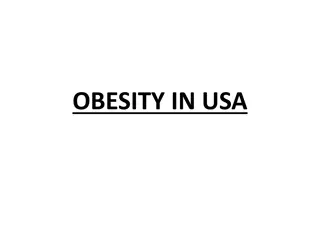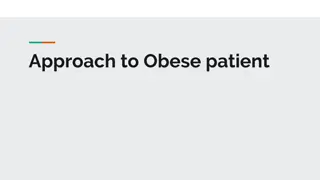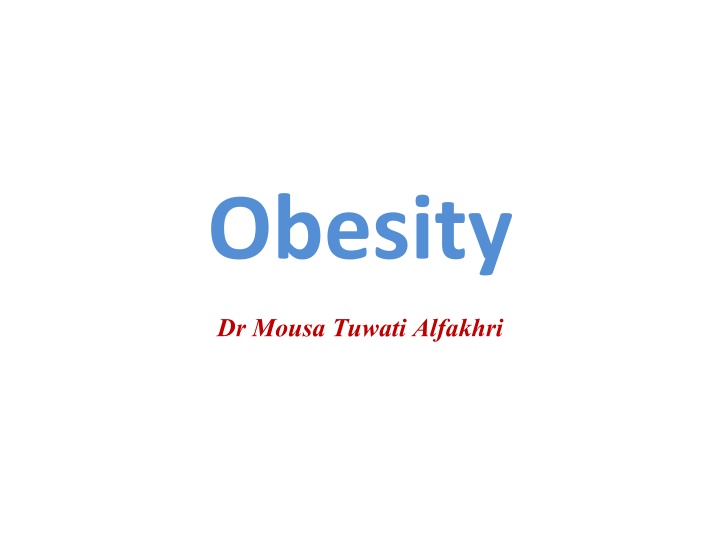
Obesity: Causes, Complications, and Management
Explore the definition, epidemiology, etiology, secondary causes, medical complications, and links to insulin resistance and type 2 diabetes in obesity. Learn about the impact of obesity on dyslipidemia and ways to address this growing health concern.
Download Presentation

Please find below an Image/Link to download the presentation.
The content on the website is provided AS IS for your information and personal use only. It may not be sold, licensed, or shared on other websites without obtaining consent from the author. If you encounter any issues during the download, it is possible that the publisher has removed the file from their server.
You are allowed to download the files provided on this website for personal or commercial use, subject to the condition that they are used lawfully. All files are the property of their respective owners.
The content on the website is provided AS IS for your information and personal use only. It may not be sold, licensed, or shared on other websites without obtaining consent from the author.
E N D
Presentation Transcript
Obesity Dr Mousa Tuwati Alfakhri
Definition It is defined as a state of excess adipose tissue. WHO definition BMI 25 is overweight BMI 30 is obesity
Epidemiology of obesity Overweight and obesity rapidly increasing globally One billion adults are overweight , and 475 million are obese. highest rates of obesity (>30%) USA, Mexico, and Middle East. 200 million school-aged children are either overweight or obese
Aetiology of obesity Genetic factors Prader Willi Syndrome, Albright Hereditary Osteodystrophy Environmental factors increased energy (food) intake or decreased energy expenditure due to physical inactivity, as the major determinants of obesity in genetically susceptible individuals
Secondary causes Hypothyroidism Cushing s disease/syndrome Insulinoma Polycystic ovary syndrome (PCOS) Iatrogenic: drugs: antipsychotic medication, hypoglycaemics ( insulin and SU) , glucocorticoids, anti-epileptic drugs Alcohol ,smoking cessation
Medical complication of obesity Insulin resistance and type 2DM Dyslipidaemia Hypertension Cardiovascular disease Reproductive disorders Hypoventilation syndrome GIT complications CNS complication Bones ,and joints complication Skin diseases Malignancies
Obesity and insulin resistance and type 2DM Mainly associated with Intra abdominal fat muscle and adipose are insulin resistant Circulating peptides TNF , IL6, Adiponectin, and Resistin have altered expression & modify the insulin action 80 % of Type 2 DM are obese
Obesity and dyslipidaemia 10% wt gain 12 mg/dl increase in cholesterol. Increase LDL, TG,and Decrease HDL Due to decrease activity of Lipoprotein Lipase. treatment of obesity improvement in dyslipidemias
Obesity and hypertension Increased blood volume Increase cardiac output Increase sympathetic tone Increase Salt sensitivity Salt retention by insulin Increase angiotensinogen
Obesity and cardiovascular disease Hypertension Dyslipidaemias Endothelial damage Diabetes W/H ratio may be the best predictor BMI > 29 3 fold rise in MI Obesity is responsible for 17% of all CVD Angina increases by 1.8 times MI increases by 3.2 and 1.5 fold in woman and men respectively
Obesity and reproductive disorders Men Plasma Testosterone and SHBG are reduced Increase Estrogen Gynaecomastia Women Increased Androgen Decrease SHBG PCOS(anovulation, obesity, hirsutism) Uterine cancer (lower body obesity ) infertility ,and low chances of IVF success
OSAS Obstructive sleep apnoea syndrome Obesity hypoventilation syndrome Old name PICKWICKIAN SYNDROME Chronic alveolar hypoventilation in Obese with BMI> 30 (PaO2 <70 PaCO2 >45 ) Cause Dysfunction of respiratory centre Repeated nocturnal sleep apnoea
OSAS Obstructive sleep apnoea syndrome Complications 1. Pulmonary hypertension 2. right sided heart falure 3. Polycythemia 4. Stroke 5. Arrythmias 7. Car accidents
GIT Gall stones Pancreatitis Abdominal hernia non-alcoholic fatty liver disease (NAFLD) GERD
CNS Stroke Blood pressure Type 2 DM Elevated cholesterol levels Depression and Sleep disturbances
Bones ,joints ,skin Osteoarthritis Trauma & joint malalignment Gout
Obesity and skin diseases Acanthosis Nigricans: Thickening of skin folds of neck, elbows, Dorsal interphalyngeal spaces Reflects severity of insulin resistance Friability of skin and varicosities. Aggravation of other conditions caused by DM 1. Necrobiosis lipoidica 2. Ulcers 3. Infections
Cancer Both sexes affected equally with high mortality rate Males: Ca. esophagus, colon, rectum, pancreas, liver& prostate Females: Ca. gall bladder, bile duct, breast, endometrium, cervix, ovaries
Measurement of obesity BMI Waist hip ratio Skin fold thickness DEXA (Dual Energy Xray Absorptiometry) CT / MRI Bioelectrical impedance analysis Total body electrical conductivity Hydrometry
Body mass index (BMI) Calculated as Weight(kg)/Height(m^2) there is Correlation between rise in BMI and Complications. BMI may be misleading in certain cases BMI may be high in a vey muscular person For similar BMIs women have greater fat mass than their male counterparts
Waist to hip ratio Central or abdominal obesity is associated with more co-morbid conditions. So measuring central obesity is of greater significance W/H ratio is taken by a simple measure tape
Skin fold thickness Harpenders callipers It is measured at biceps/triceps/ and interscapular Normal: < 40 mm in males, < 50 mm in females
Management of an obese patient History Current eating habits and triggers for eating/activity levels. Family history of obesity and obesity-related disease. Symptoms or previous diagnosis of obesity-related diseases, including CVD, diabetes, psychological issues (eating disorder, depression, low self-esteem), OA, obstructive sleep apnoea, PCOS. Other risks, such as smoking and alcohol intake. Drugs that exacerbate weight gain.
Examination Height, weight, fat distribution. Skin: acanthosis nigricans and skin tags (insulin resistance), intertrigo, fat distribution . Cardiovascular: hypertension, heart failure Respiratory: airway, obstructive sleep apnoea (somnolence), pulmonary hypertension. GI: hepatomegaly, herniae Musculoskeletal: mobility. Consider other diagnoses: hypothyroidism, Cushing s syndrome
Investigations CBC (iron deficiency anaemia from reflux or GI bleeding; polycythaemia from hypoventilation). Renal function. Liver function (non-alcoholic steatohepatitis). Glucose, HbA1c (prediabetes, diabetes). Fasting lipid profile (raised triglycerides, total and LDL cholesterol, lowered HDL cholesterol). Vitamin D (often deficient in the obese). Thyroid function (hypothyroidism). ECG (atrial fibrillation, left ventricular hypertrophy)
Goal is to reduce or prevent comorbidities. Diet Therapy Physical Activity Therapy Behavioral Therapy Pharmacotherapy Surgery
Diet Low calorie diet Low in saturated fats Normal protein intake Increased fibers in diet 1000 K cal deficit produces 1 kg wt loss per week
Pharmacotherapy Indications 1. BMI > 30 2. BMI > 27 with risk factors like HT, DM, CHD, Sleep Apnoea, Dyslipidemia Orlistat Saxenda
Orlistat : is a gastrointestinal and pancreatic lipase inhibitor that induces weight loss by inhibiting dietary fat absorption Liraglutide(saxenda) is a glucagonlike peptide- 1 (GLP-1) analog ,acts by decreasing the appetite and calorie intake.
Bariatric surgical techniques Indications 1. BMI greater than 40, or 100 pounds overweight 2. BMI 35-39.9 and a life-threatening condition, such as heart disease or diabetes. 3. BMI 35-39.9 and severe physical limitations that affect employment, mobility, and family life
Bariatric surgical techniques Divided into two groups 1. Malabsorptive procedures - Induce decreased absorption of nutrients by shortening functional length of small intestine 2. Restrictive procedures - Reduce storage capacity of stomach and as result early satiety arises, leading to decreased caloric intak
Malabsorptive procedures Jejunoileal bypass Biliopancreatic diversion Biliopancreatic diversion with duodenal switch Restrictive procedures Vertical banded gastroplasty Laparoscopic adjustable gastric band
THANKS THANKS


